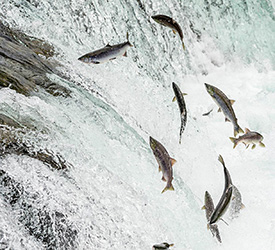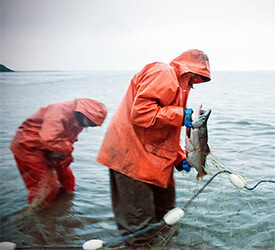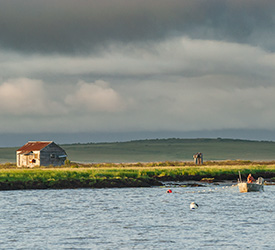FAIR TRADE & ALASKA FISHERIES

Why Fair Trade?
The Fair Trade program views fishermen, workers, businesses and consumers as partners in an ecosystem. While each stakeholder has separate goals, together they can invest into a better future by harnessing the power of markets.
Fair Trade Seafood Advantages:
- Offering consumers a holistic choice for seafood that is sourced to be socially responsible and is harvested in a way that benefits the long-term sustainability of the supply chain.
- Creating more resilient livelihoods in coastal communities through safe working and living conditions.
- Auditing the transactions to guarantee that fishermen are paid an above-market price and annually inspecting the fisheries to ensure the strict socioeconomic criteria are being met.
The Fair Trade USA Program
Challenges
In today’s competitive market, businesses are constantly looking for ways to cut costs. Often, this is done at the expense of the providers at the ground level — fishermen, farmers and other producers.
When producers don’t receive fair compensation, it doesn’t just compromise their livelihood. It impacts their families and entire communities, especially in remote and economically depressed areas.
Solutions
The Fair Trade program is a global model that works to solve the problem. It promotes sustainable and equitable trade practices that positively impact multiple stakeholders — producers, communities, businesses and consumers — and minimize environmental impact.
To receive Fair Trade certification, producers and businesses must meet rigorous economic, social and environmental standards. Producers agree to meet certain sustainability standards that protect both workers and the environment. In exchange, the producers participate in equitable trade partnerships with distributors and buyers.
The buyers pay their supplier partners Fair Trade minimum prices that are above average market numbers. The businesses that sell Fair Trade certified products also pay a premium that goes into a community-development fund. Each community decides how to invest these funds into services such as healthcare, education and infrastructure.
Impacts
The Fair Trade program became available globally in the seafood industry in 2014 through Fair Trade USA, a nonprofit founded in 1998 that is a leading Fair Trade third-party certifying partner in North America.
Through its minimum-price program, Fair Trade USA has provided $295 million in community development funds and $146 million to producers in impoverished countries.
Requirements
Fair Trade USA’s rigorous standards include requirements for resource management that protects the ecosystem and biodiversity. For seafood, the Fair Trade certification is an all-in-one solution because it solves many of the industry’s issues, including traceability and supply-chain stability.
The Captures Fisheries Fair Trade Program sets a higher standard in the marketplace for quality seafood. At the same time, it empowers fishers to make social and environmental improvements that benefit their fishery.
Since its launch in 2014, the Fair Trade seafood program has certified nine supply chains as of April 2018. The certified fishermen have earned a total of $650,000 in Fair Trade premiums toward their community-development funds.
Sustainability First

Sustainable Fisheries
Sustainable fishing ensures that the health of the marine ecosystem remains intact. In turn, fishermen can maintain their livelihood for generations to come.
Sustainable Principles Include:
- Leaving enough fish in the ocean so that the fish population remains productive.
- Minimizing environmental impacts.
- Managing fisheries in a way that adapts to the changes in the environment.

Sustainable Environment
To participate in Fair Trade, fishermen must adopt responsible practices that protect the marine resources and their biodiversity. Over time, the goal is to help fisheries improve and meet international best practices.
These environmentally responsible practices help minimize the impact from the industry on the marine ecosystem and the health of the oceans.

Sustainable Jobs & Wages
Both fishermen and workers have more sustainable livelihoods when they have access to markets, business skills, safe working conditions and fair wages. Fair Trade standardizes wages and benefits. The wage requirements result in increased income and measurable economic change for fishers and workers.

Sustainable Communities
Fair Trade aims to bring economic development to impoverished, struggling communities. These communities are typically isolated by geography and face economic, social and environmental instability.
The Fair Trade model brings an influx of community funds that can be invested into local programs and infrastructure. The communities become less vulnerable to unpredictable market forces and improve their resiliency.
